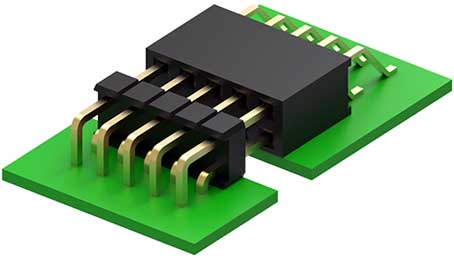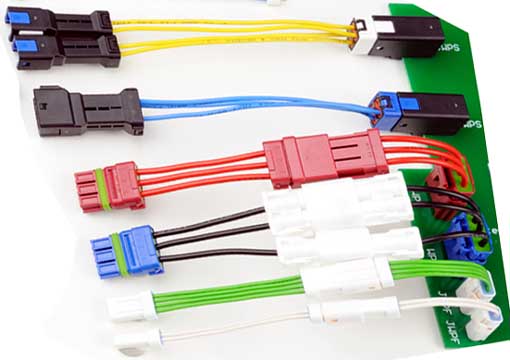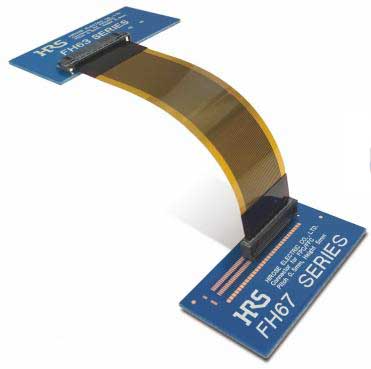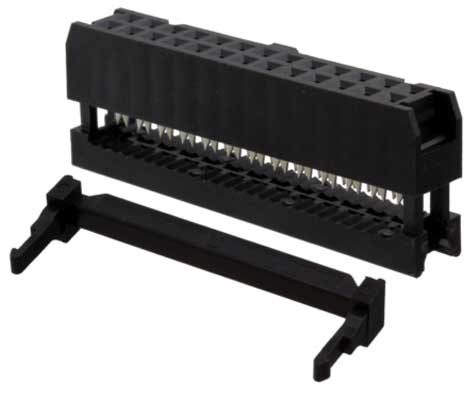How to choose a board-to-board connector?

Board-to-board connector manufacturers tell you how to choose connectors? There are many types of connectors. Common types include communication interface terminals, wiring terminals, wire-to-board connectors, and board-to-board connectors. Each category can be subdivided into several categories, such as:
Board-to-board connectors include: Pin header and female header, board-to-board connector, etc.;
Wire-to-board connectors include: FPC connector, IDC socket, simple horn socket, etc. So when choosing connectors, from which angles should we consider connectors suitable for hardware use?
1. Pins and spacing
The number of pins and the spacing between pins are the basic basis for connector selection. The number of pins selected for the connector depends on the number of signals to be connected. For some patch connectors, the number of pins in the patch headers as shown in the figure below should not be too much. Because in the soldering process of the placement machine, due to the effect of high temperature, the connector plastic will be heated and deformed, and the middle part will bulge, resulting in false soldering of the pins. Our P800Flash programmer used this kind of header and female header for inter-board connection in the early stage of development. As a result, the pins of the prototype header were soldered in a large area. After changing to 2 pin headers with halved pins, there was no false soldering.
Nowadays, electronic equipment is developing towards miniaturization and precision, and the pin pitch of the connector has also changed from 2.54mm to 1.27mm to 0.5mm. The smaller the lead pitch, the higher the requirements for the production process. The lead spacing should be determined by the company's production process level, and can not blindly pursue small spacing

2. Electrical performance
The electrical performance of the connector mainly includes:
Limit current, contact resistance, insulation resistance and dielectric strength, etc. When connecting a high-power power supply, pay attention to the limit current of the connector;
When transmitting high frequency signals such as LVDS, PCIe, etc., pay attention to contact resistance. The connector should have a low and constant contact resistance, generally tens of mΩ to hundreds of mΩ.
3. Environmental performance
The environmental performance of the connector mainly includes: resistance to temperature, humidity, salt spray, vibration, shock, etc. Choose according to specific application environment. If the application environment is relatively humid, the requirements for resistance to humidity and salt spray of the connector are high to avoid corrosion of the metal contacts of the connector. In the field of industrial control, the requirements for the anti-vibration and shock performance of the connector are high to prevent the connector from falling off during the vibration process.

4. Mechanical properties
The mechanical properties of the connector include insertion force, mechanical foolproof, etc. Mechanical foolproof is very important to the connector. Once plugged in reverse, it is likely to cause irreversible damage to the circuit!
The number of pins and the spacing between pins are the basic basis for connector selection. The number of pins selected for the connector depends on the number of signals to be connected. For some patch connectors, the number of pins in the patch headers as shown in the figure below should not be too much. Because in the soldering process of the placement machine, due to the effect of high temperature, the connector plastic will be heated and deformed, and the middle part will bulge, resulting in false soldering of the pins. Our P800Flash programmer used this kind of header and female header for inter-board connection in the early stage of development. As a result, the pins of the prototype header were soldered in a large area. After changing to 2 pin headers with halved pins, there was no false soldering.
Nowadays, electronic equipment is developing towards miniaturization and precision, and the pin pitch of the connector has also changed from 2.54mm to 1.27mm to 0.5mm. The smaller the lead pitch, the higher the requirements for the production process. The lead spacing should be determined by the company's production process level, and can not blindly pursue small spacing

2. Electrical performance
The electrical performance of the connector mainly includes:
Limit current, contact resistance, insulation resistance and dielectric strength, etc. When connecting a high-power power supply, pay attention to the limit current of the connector;
When transmitting high frequency signals such as LVDS, PCIe, etc., pay attention to contact resistance. The connector should have a low and constant contact resistance, generally tens of mΩ to hundreds of mΩ.
3. Environmental performance
The environmental performance of the connector mainly includes: resistance to temperature, humidity, salt spray, vibration, shock, etc. Choose according to specific application environment. If the application environment is relatively humid, the requirements for resistance to humidity and salt spray of the connector are high to avoid corrosion of the metal contacts of the connector. In the field of industrial control, the requirements for the anti-vibration and shock performance of the connector are high to prevent the connector from falling off during the vibration process.

4. Mechanical properties
The mechanical properties of the connector include insertion force, mechanical foolproof, etc. Mechanical foolproof is very important to the connector. Once plugged in reverse, it is likely to cause irreversible damage to the circuit!
The insertion force is divided into insertion force and separation force. The relevant standards specify the maximum insertion force and minimum separation force. From the perspective of use, the insertion force should be small and the separation force should be large. If the separation force is too small, the reliability of the contact will be reduced. However, for connectors that often need to be plugged and unplugged, too much separation force will increase the difficulty of unplugging and reduce mechanical life.
In order to reduce the separation force of the connector and facilitate the user to plug and unplug the adapter board, we have made many attempts and finally found a bright light on the road of exploration. Finally choose the connector shown in the figure below, and modify the PCB and product shell structure.
The actual test shows that this connector has obvious protective effect due to the unique directionality of the slot, and the insertion force is small, the separation force is moderate, and the insertion and removal feel is good, which greatly improves the convenience of use of the insertion and removal.
In order to reduce the separation force of the connector and facilitate the user to plug and unplug the adapter board, we have made many attempts and finally found a bright light on the road of exploration. Finally choose the connector shown in the figure below, and modify the PCB and product shell structure.
The actual test shows that this connector has obvious protective effect due to the unique directionality of the slot, and the insertion force is small, the separation force is moderate, and the insertion and removal feel is good, which greatly improves the convenience of use of the insertion and removal.






